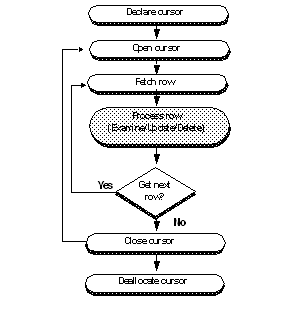SQL was conceived as a set-oriented language. Adaptive Server is extremely efficient when it works in set-oriented mode. Cursors are required by ANSI SQL standards; when they are needed, they are very powerful. However, they can have a negative effect on performance.
For example, this query performs the identical action on all rows that match the condition in the where clause:
update titles
set contract = 1
where type = ’business’
The optimizer finds the most efficient way to perform the update. In contrast, a cursor would examine each row and perform single-row updates if the conditions were met. The application declares a cursor for a select statement, opens the cursor, fetches a row, processes it, goes to the next row, and so forth. The application may perform quite different operations depending on the values in the current row, and the server’s overall use of resources for the cursor application may be less efficient than the server’s set level operations. However, cursors can provide more flexibility than set-oriented programming.
Figure 28-2 shows the steps involved in using cursors. The function of cursors is to get to the middle box, where the user or application code examines a row and decides what to do, based on its values.
